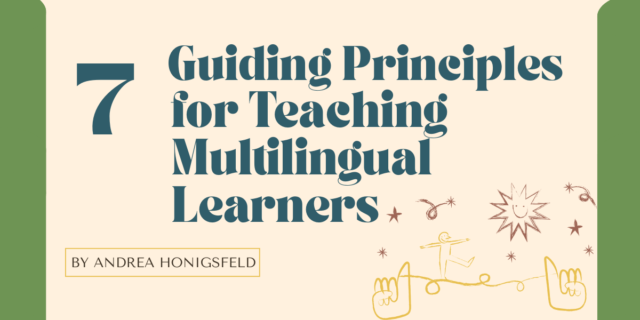
Written by Andrea Honigsfeld.
***
If you are a secondary educator, coach, or administrator who is teaching and supporting multilingual learners (sometimes referred to as English learners), you are likely already familiar with many of the challenges and joys of guiding multilingual students on a journey of cultural, linguistic, and academic exploration. You know that while your multilingual students bring rich experiences and knowledge to your classrooms, they are also learning within environments that privilege English, a language they are still learning. You know that your students who have recently moved to the United States are expected to meet standards and adhere to norms that might be significantly different from their previous learning experiences. And, most of all, you know that addressing multiple language and literacy proficiencies in a single classroom requires a different set of tools and skills than teaching in a monolingual environment.
In my experience as a teacher, professor, consultant, and lecturer, I’ve found that educators, coaches, and administrators are eager to find ways to help their multilingual students flourish academically and socially, no matter where they are on their journey of language development. That’s why I wrote the Growing Language and Literacy series: to bring some of the best strategies I’ve seen in classrooms to you, the professionals who shape multilingual students’ experiences at school.
Growing Language and Literacy, 6-12: Strategies for Secondary Multilingual Learners, the most recent book in the series, is practical—a ready-to-use, accessible, richly-illustrated guide that offers lots of evidence-based, research-informed, classroom-tested guidance and concrete examples of what works with adolescent multilingual learners. The book is organized into five chapters that correspond to the five levels of language acquisition: starting, emerging, developing, expanding and bridging. (These levels are based on the widely-used TESOL framework, which is similar to WIDA’s framework and other existing frameworks used in the United States and internationally.) This means that you can turn to a chapter to find strategies tailored to your students’ language development levels.
While the book includes much practical help, it is more than a practical book. The suggestions in these pages offer ways to meet students where they are and to ensure that they can bring their whole selves to school each day. Each chapter discusses the challenges and opportunities that students often encounter at each level, to help you better understand your students’ perspectives. The book is filled with powerful examples of student work, as a reminder of just how much our students are capable of. The goal is to help students become successful in U.S. schools and society but never at the expense of sacrificing their existing cultural and linguistic competences.



***
Listen to Andrea Honigsfeld and Alycia Owen on the Heinemann podcast discuss the newly released book.
A new edition of the bestselling Growing Language and Literacy, tailored for secondary teachers! Practical strategies that can be applied across grade levels and content areas to support adolescent multilingual learners.

Dr. Andrea Honigsfeld is TESOL professor at Molloy University, Rockville Centre, NY. Before entering the field of teacher education, she was an English as a Foreign Language teacher in Hungary (grades 5-8 and adult), an English as a Second Language teacher in New York City (grades K-3 and adult), and taught Hungarian at New York University. A Fulbright Scholar and sought after national presenter, Andrea is the coauthor or coeditor of 27 books on education and numerous chapters and research articles related to the needs of diverse learners. Andrea is coauthor of the Core Instructional Routines books with Judy Dodge. Visit Andrea at www.andreahonigsfeld.com.



